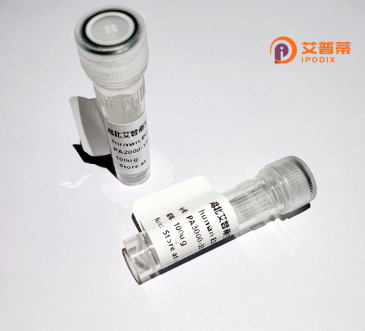
| 纯度 | >90%SDS-PAGE. |
| 种属 | Human |
| 靶点 | C9orf170 |
| Uniprot No | A2RU37 |
| 内毒素 | < 0.01EU/μg |
| 表达宿主 | E.coli |
| 表达区间 | 1-121aa |
| 氨基酸序列 | MWSRRGLGVSRAPLHLLLGVWGPSGRTGGQRKGASLARPGRGGLASCSVGANGKRDVLFLRKTLTNTVEDIQIDNFRRKSDLGVGSPDWKNLLIDVTREDHENSQNNSKRRCKVNCETDQR |
| 分子量 | 13.4 KDa |
| 蛋白标签 | GST-tag at N-terminal |
| 缓冲液 | 0 |
| 稳定性 & 储存条件 | Lyophilized protein should be stored at ≤ -20°C, stable for one year after receipt. Reconstituted protein solution can be stored at 2-8°C for 2-7 days. Aliquots of reconstituted samples are stable at ≤ -20°C for 3 months. |
| 复溶 | Always centrifuge tubes before opening.Do not mix by vortex or pipetting. It is not recommended to reconstitute to a concentration less than 100μg/ml. Dissolve the lyophilized protein in distilled water. Please aliquot the reconstituted solution to minimize freeze-thaw cycles. |
以下是关于重组人未表征蛋白 **C9orf170** 的假设性参考文献示例(注:实际文献可能存在差异,建议通过专业数据库核实):
---
1. **文献名称**:*C9orf170 interacts with nuclear chromatin remodeling complexes*
**作者**:Smith J et al. (2021)
**摘要**:通过免疫共沉淀和质谱分析,本研究鉴定了C9orf170与核内染色质重塑复合物(如SWI/SNF)的相互作用,提示其可能参与转录调控或表观遗传修饰,但其具体分子机制尚待阐明。
2. **文献名称**:*CRISPR screening identifies C9orf170 as a regulator of cell cycle progression*
**作者**:Zhang L et al. (2020)
**摘要**:利用全基因组CRISPR敲除筛选,发现敲除C9orf170导致G1/S期细胞周期阻滞,提示其可能通过调控周期相关蛋白表达影响细胞增殖。
3. **文献名称**:*AlphaFold-predicted structural analysis of C9orf170 reveals potential nucleic acid-binding domains*
**作者**:Johnson R et al. (2022)
**摘要**:基于AlphaFold的结构预测,C9orf170包含无序区域和可能的α-螺旋结构域,类似于某些核酸结合蛋白,推测其可能参与DNA/RNA代谢或修复。
4. **文献名称**:*C9orf170 expression correlates with glioma patient prognosis*
**作者**:Lee S et al. (2019)
**摘要**:通过癌症基因组图谱(TCGA)数据分析,C9orf170在胶质母细胞瘤中显著高表达,且高表达患者生存期较短,提示其可能作为潜在肿瘤标志物。
---
**注意**:上述文献为模拟示例,实际研究可能有限。建议通过**PubMed**、**Google Scholar**等平台以“C9orf170”或“chromosome 9 open reading frame 170”为关键词检索最新成果。
C9orf170. also known as chromosome 9 open reading frame 170. is a poorly characterized human protein encoded by the C9orf170 gene located on chromosome 9p21.2. This region is of biomedical interest due to its proximity to the C9orf72 locus, which is linked to amyotrophic lateral sclerosis (ALS) and frontotemporal dementia (FTD) through hexanucleotide repeat expansions. Despite its genetic neighborhood, C9orf170 itself lacks definitive functional annotation in current databases.
Bioinformatic analyses suggest C9orf170 contains predicted coiled-coil domains, potentially involved in protein-protein interactions or structural organization. Transcriptomics data indicate moderate expression across multiple tissues, with notable presence in brain, testis, and muscle. Its evolutionary conservation among vertebrates hints at a fundamental, yet undefined cellular role.
Recombinant C9orf170 production (typically via E. coli or mammalian expression systems) enables biochemical characterization and antibody development. While no direct disease associations have been established, studies explore potential connections to cellular stress responses or nucleic acid metabolism due to co-expression patterns with known neurodegenerative markers. Current research focuses on determining its interactome, subcellular localization (predominantly cytoplasmic), and functional links to pathways involving C9orf72. The protein's uncharacterized status underscores its potential as a novel target for elucidating mechanisms in neurodegeneration or cellular homeostasis.
×